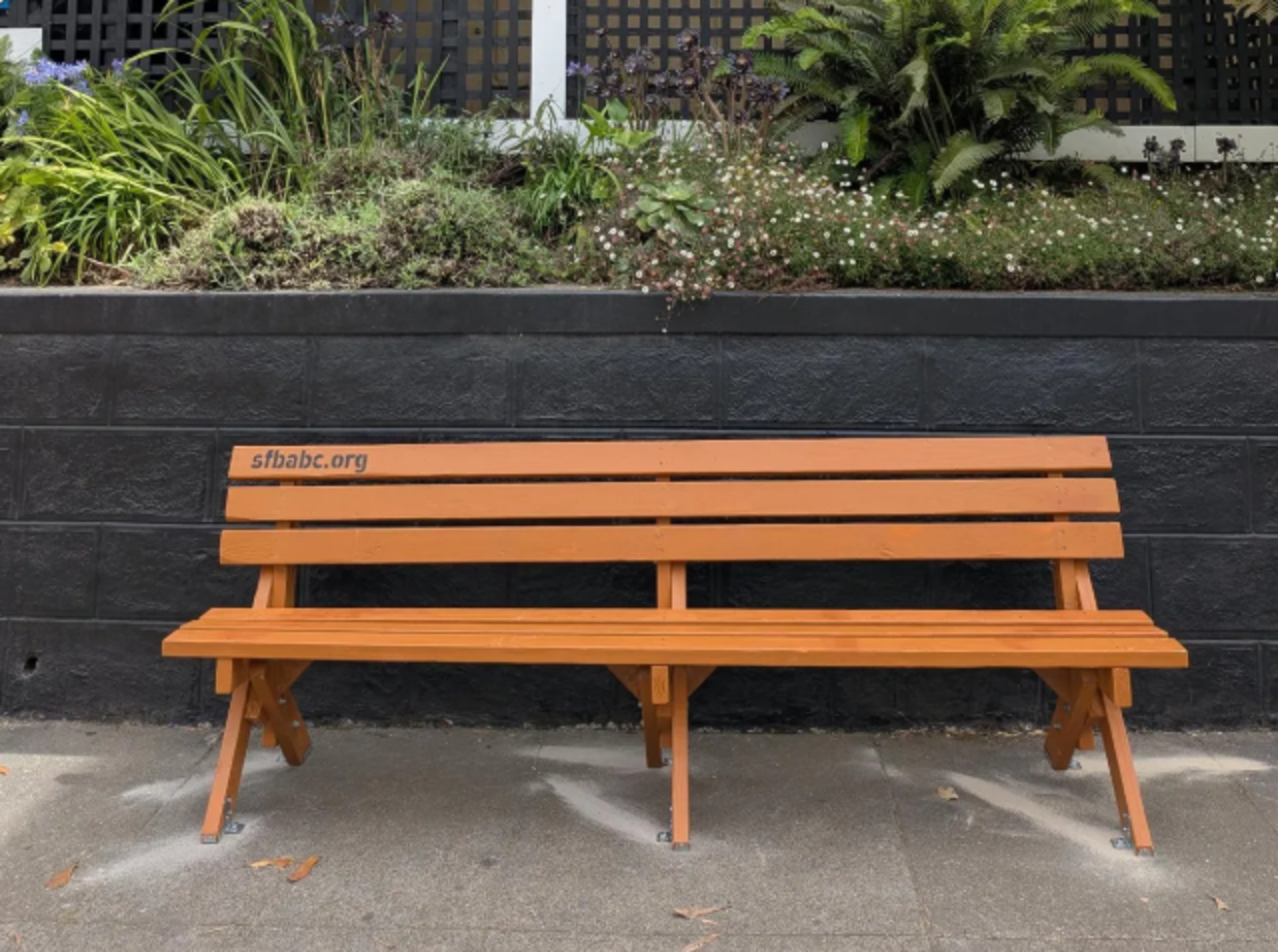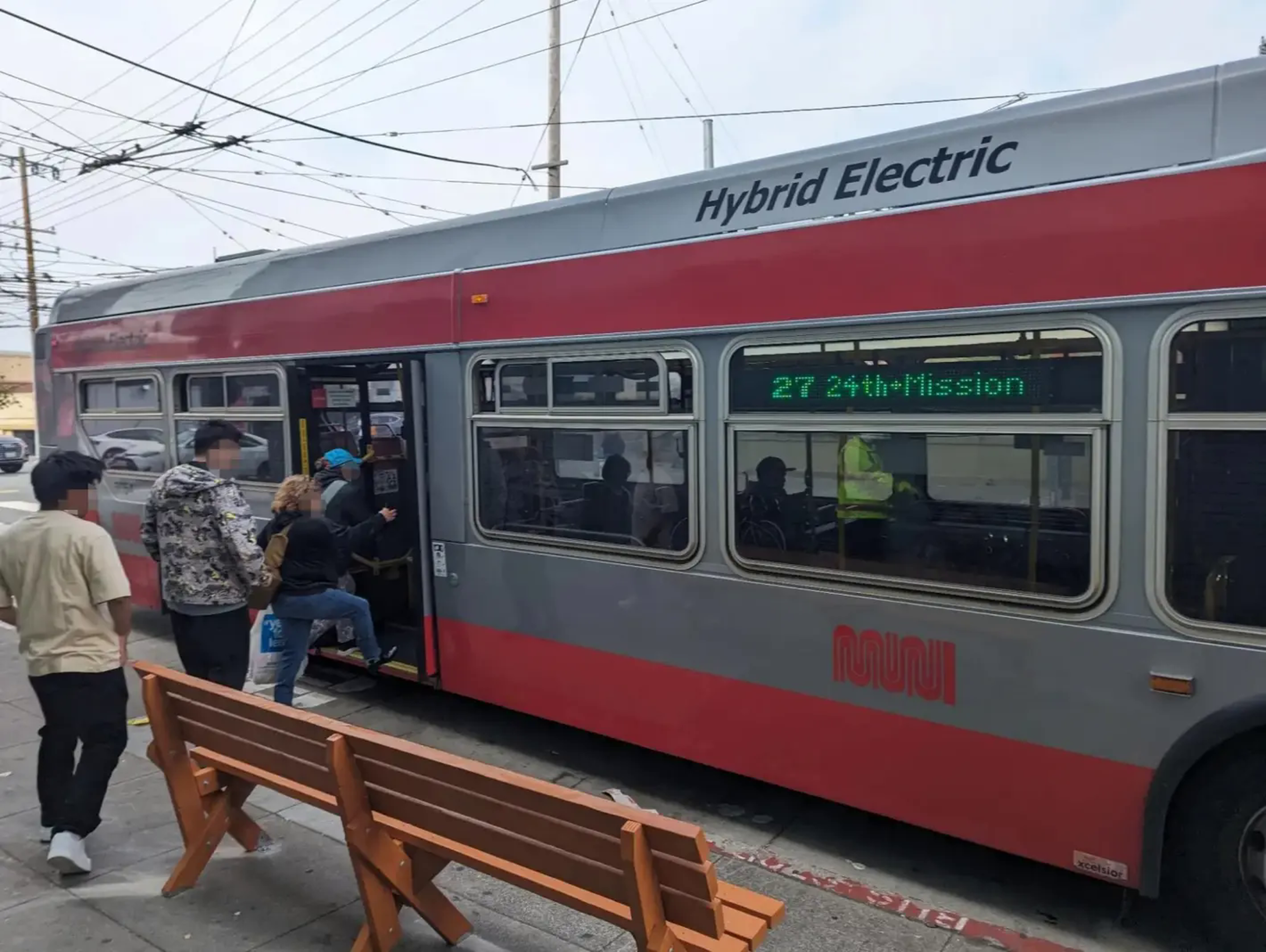The media like to call us “guerillas (opens in new tab)” and “rogues (opens in new tab).” That may be true, but we’re also groups of friends and neighbors who volunteer time, energy, and woodworking skills to make strangers’ lives a little easier.
We’re actually called the San Francisco Bay Area Bench Collective (opens in new tab).
We’ve been working for two years in the East Bay, installing almost 100 benches (opens in new tab) at bus stops. The materials for one bench cost around $70 (funded by contributions), and a group can build 10 benches in a weekend. Now we’re bringing benches to San Francisco, where passengers ride Muni 521,000 (opens in new tab) times every weekday, yet roughly 66% of bus stops — nearly 2,000 — lack seating.
It doesn’t have to be this way.
Last month, we installed eight benches at Muni stops in the Mission and Noe Valley to make them more accessible and comfortable. The benches have been a big hit — people started using them within minutes and showed appreciation on social media (opens in new tab). Press coverage features people grateful (opens in new tab) for a place to sit and supportive (opens in new tab) of our efforts.
Each bench-building party is a joyous thing. Dozens of volunteers gather to sand, drill, saw, paint, bolt, and install the 8-foot-long benches. We include everyone from students to parents to seniors, from people with full-time jobs to retirees. Some get an excuse to use power tools they might not have touched in years; others get lessons in safety and basic woodworking. We carefully consider and discuss which placements near public transit stops will make the most impact, considering ridership, terrain, demography, and other factors. In most cases, we transport (opens in new tab) a bench to its installation site by e-bike.

In an ideal world, we would not exist. San Francisco would have the necessary resources and political will to install benches at every Muni stop. But we’re not holding our breath. In fact, the Municipal Transportation Agency is reducing accessibility and comfort for San Franciscans by facilitating the removal (opens in new tab) of some of the few transit shelters we have, following the same backward logic that removing trash cans (opens in new tab) will lead to less trash.
In the absence of effective governance, our community can and will step up. At a minimum, San Francisco should adopt the “live and let live” approach to our benches that Oakland and Berkeley have taken, allowing them to stay unless they can be replaced with official installations.
Better yet, San Francisco could follow the example of Richmond by creating a permit process (opens in new tab) to make community-provided benches official. San Francisco’s newly re-launched Love Our Neighborhoods (opens in new tab)program— the first iteration of which included installations like Little Free Libraries, benches, and planters—still requires property owners to consent and excludes bus stops. We would love further expansion of this program to include bus stop benches.
Sidewalk planters are a DIY initiative on San Francisco’s sidewalks that predates our benches. In recent years, large metal planters (opens in new tab)have popped up all over the city, installed by residents seeking to dissuade homeless encampments, or at least push them to somebody else’s block. Though these planters are unpermitted, just like our benches, they have been condoned by the city. They’ve even been installed with help from (opens in new tab) the Department of Public Works, in potential violation of a court injunction. Benches are the opposite of planters, making the sidewalk more comfortable instead of more hostile. It’s a sad sign of the times that hostile architecture faces fewer procedural headwinds than functional street furniture.

In comments (opens in new tab) to the media, the Department of Public Works has raised a legitimate question: Who should handle maintenance of our DIY benches? Wood doesn’t last forever, and any new street furniture can be a canvas for graffiti. In response to such questions, we ask our volunteers to sign up (opens in new tab) to adopt a bench, which entails painting over tags and reporting any structural damage so the bench can be repaired or replaced. Graffiti is a problem mainly in that it leads to complaints and, therefore, possible removal, but a bench covered in graffiti is still more useful than no bench. These benches can even become art pieces (opens in new tab).
Given the legitimacy of this concern, a reasonable compromise would be to make the permit process specify the maintenance obligation of the installer and establish communication channels to notify installers if a bench needs removal.
A bench is a simple and small thing, but a moment of rest on a busy day can have a big impact. In a city and a country that seems to grow more hostile with every passing day, neighbors all over the Bay Area are finding a way to bring people together. Building a bench is quite literally a labor of love, for the city and for one another.
You don’t have to know us to get involved — just check out the plans (opens in new tab) we’ve posted. As long as there are bus stops without benches, we need your help, be it by contributing funds (opens in new tab), maintaining an existing bench (opens in new tab) in your neighborhood, or picking up a sander or a jigsaw and building with us (opens in new tab). The benches won’t build themselves.
The San Francisco Bay Area Bench Collective (opens in new tab) is a decentralized collection of people and groups building and installing benches at bus stops around the region.
